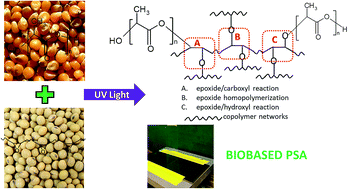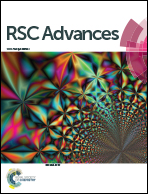Copolymers from epoxidized soybean oil and lactic acid oligomers for pressure-sensitive adhesives
Abstract
Plant oils and polysaccharide-derived lactic acid are two renewable chemicals that are important in producing industrial biopolymers. In this investigation, we copolymerized epoxidized soybean oil (ESO) with lactic acid oligomers for pressure-sensitive adhesive (PSA) applications. Lactic acid oligomers (OLAs) with molecular weights of 260 to 674 g mol−1 were synthesized without catalysts or solvents. Both carboxyl and hydroxyl groups of OLAs are able to open the epoxide ring of the ESO triglycerides to form polymer networks. Thermal, mechanical, and viscoelastic properties of the copolymers were studied for potential applications as single-component pressure-sensitive adhesives (PSAs). Glass transition temperatures (Tg) of copolymers increased from −21 to 5 °C as chain lengths of OLAs increased. Copolymers based on relatively short-chain OLAs exhibited a maximal peel adhesion strength of 3.8 N cm−1, tack adhesion of 8.0 N cm−1, and shear adhesion resistance of over 30 000 minutes. We also found positive correlations between mechanical performance and viscoelastic response at bonding and debonding frequencies for these copolymers. The new polymers are favorable candidates for fully biobased PSAs.


 Please wait while we load your content...
Please wait while we load your content...